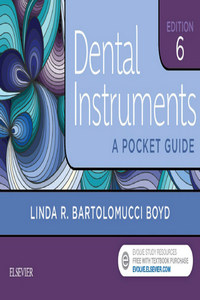Description
Dental Instruments: A Pocket Guide, 6 Edition by Linda Bartolomucci Boyd Test Bank
-
Table of Contents
1. Basic Dental Instruments
2. Enamel Cutting Instruments
3. Local Anesthetic Syringe/Components and Nitrous Oxide Sedation
4. Evacuation Devices, Air/Water Syringe Tip, and Dental Unit
5. Dental Handpieces
6. Burs and Rotary Attachments for Handpieces
7. Dental Dam Instruments
8. Amalgam Restorative Instruments
9. Composite Restorative Instruments
10. Crown and Bridge Restorative Instruments
11. Endodontic Instruments
12. Hygiene Instruments
13. Preventive and Sealing Instruments and Bleaching Trays
14. Orthodontic Instruments
15. Universal Surgical Instruments
16. Periodontal Instruments and Periodontal Surgical Instruments
17. Oral Surgery Extraction Instruments
18. Sterilization Equipment
19. Dental Materials Equipment
20. Dental Imaging and Diagnostic Equipment
21. Vital Signs and Beyond
Index
Chapter 01: Basic Dental Instruments Boyd: Dental Instruments, 6th Edition
MULTIPLE CHOICE
1. What is the purpose of the mouth mirror?
- Provide indirect vision.
- Reflect light into the mouth.
- Retract the lips, cheeks, and tongue.
- A and C
- All of the above
ANS: E
The purpose of the mouth mirror is to provide indirect vision, light reflection, and retraction.
REF: Page 3 TOP: CDA, GC, II. Chairside Dental Procedures
2. What is the purpose of the explorer?
- Retract the lips, cheeks, and tongue.
- Transfer material from the oral cavity.
- Examine teeth for decay, calculus, or other abnormalities.
- All of the above
ANS: C
The thin, sharp, flexible tip is ideal to check the teeth for dental caries and to detect calculus and furcations but would prove injurious to the patient if used for retraction.
The tip of the working end is too small to be used as a transfer instrument.
REF: Page 5 TOP: CDA, GC, II. Chairside Dental Procedures
3. The main function of this instrument is to grasp and/or transfer material into and out of the oral cavity.
- Curette
- Mouth mirror
- Periodontal probe
- Cotton forceps (pliers)
ANS: D
The main function of cotton forceps is to grasp and transfer. The probe, mouth mirror, and curette do not have features for grasping.
REF: Page 7 TOP: CDA, GC, II. Chairside Dental Procedures
4. Which of the following instruments is part of a basic setup for most dental procedures?
- Curette
- Spoon excavator
- Periodontal probe
- Cotton forceps (pliers)
ANS: D
The cotton forceps is a useful instrument for most all procedures. The curette and periodontal probe are instruments used in a prophylaxis or periodontal examination. A spoon excavator is used to remove dental caries and is part of a restorative procedure.
REF: Page 11 TOP: CDA, GC, II. Chairside Dental Procedures
5. Which type of mouth mirror reflects magnifies the image?
- Double-sided mirror
- Front surface mirror
- Concave mirror
- All of the above
ANS: B
The front surface mirror produces the most accurate image. A double-sided mirror may have a front surface feature, or it may not. A concave mirror magnifies the image and does not provide an accurate representation.
REF: Page 3 TOP: CDA, GC, II. Chairside Dental Procedures
6. Why is using a variety of instrument handle diameters beneficial to the dental professional?
- Helps in lightening the instrument grasp.
- Maximizes control of the instrument.
- Lessens the stress associated with carpal tunnel syndrome.
- Minimizes fatigue when using the instrument.
ANS: C
It has been proven that changing the energy needed to grasp an instrument, which causes muscle fatigue and stress, can lessen the stress associated with carpal tunnel syndrome.
REF: Page 9 TOP: CDA, GC, II. Chairside Dental Procedures
Copyright © 2018, Elsevier Inc. All Rights Reserved. 1
7. Which type of mouth mirror is used in disposable mirrors?
- Double-sided mirror
- Front surface mirror
- Flat surface mirror
- Concave mirror
ANS: C
The flat surface mirror is used in disposable mirrors.
REF: Page 3 TOP: CDA, GC, II. Chairside Dental Procedures
8. Which statement is correct about cotton forceps?
- Comes in one size
- Has plain or serrated tips
- Has pointed or rounded tips
- B and C only
- All of the above
ANS: D
Characteristics of cotton forceps include, plain or serrated tips, pointed or rounded tips and thin or thick tips. They can be locking or non-locking and there are a range of sizes to choose from.
REF: Page 7 TOP: CDA, GC, II. Chairside Dental Procedures
9. Which instrument would NOT be found on a basic tray set-up?
- Mouth mirror
- Sickle scaler
- Explorer
- All of the above are found on the basic tray.
ANS: B
A sickle scaler would not be found on a basic tray set-up. A basic tray would include a mouth mirror, explorer and cotton forceps.
REF: Page 11 TOP: CDA, GC, II. Chairside Dental Procedures




Be the first to review “Dental Instruments: A Pocket Guide, 6 Edition by Linda Bartolomucci Boyd Test Bank”